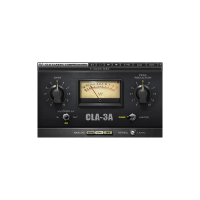We recommend placing the L1 last in the processing chain to maximize the signal’s sonic integrity. If not
placed last in the chain, the L1 will still work but the absolute brick-wall limiting and benefits of IDR re-
quantization will be compromised; further limiting may be necessary to maintain the original level.
Processing after the L1 will likely increase the signal’s wordlength and peak values.
L1 component plug-ins
As of this release, the L1 has two plug-in components:
L1-Limiter - mono/stereo wideband limiter without IDR (track insert, voice or instrument limiter, SFX
maximizer)
L1-UltraMaximizer- the full mastering plug-in with limiter and all IDR options (CD mastering, multime-
dia authoring)
Important Digital Audio Facts for Optimal L1 Use
Maximum Level
The maximum level of a digital signal is determined by the song or track’s highest peak value.
Simple normalization finds the highest peak, then raises the entire signal so that this peak is at the
maximum value. Many of these peaks, however, may be of short enough duration to be reduced by
several dB without audible side effects. This allows the entire level to be raised several dB, resulting
in a higher average signal level.
The L1-UltraMaximizer avoids overshoot by utilizing a look-ahead technique that anticipates and
reshapes signal peaks to minimize audible artifacts. This allows the L1 to be used with absolute con-
fidence in situations that require brick-wall limiting.
Maximum Resolution and IDR™
DSP that alters the original digital data (mixing, gain changes, EQ, dynamic processing, etc.) typical-
ly increases the bit width required to represent the signal. Conventional truncation reduces signal
resolution with each process, which deprives the signal of spaciousness and transparency.
The Waves IDR process, based on Michael Gerzon’s noise-shaping, re-dithering technique, prevents
this loss of critical low-level detail. IDR offers two dither types and three noise-shaping curves to
optimize processing of a wide variety of applications and source material. It signifies a major
advance in preserving and actually increasing the resolution of a processed digital signal. IDR can be
used during each process (i.e.,16-bit), or once at the end of a high-resolution chain (i.e., 24-bit), to
ensure the maximum resolution of the final signal. IDR is particularly beneficial when data is delib-
erately re-quantized from 24- to 16-bit, 16-bit to 8-bit, etc. Dithered outputs of 20-,16-,12-, and 8-
bit are available from the L1-UltraMaximizer. This is very helpful during final file preparation, mas-
tering, and quantization or re-quantization.
Y56K User Guide
36

